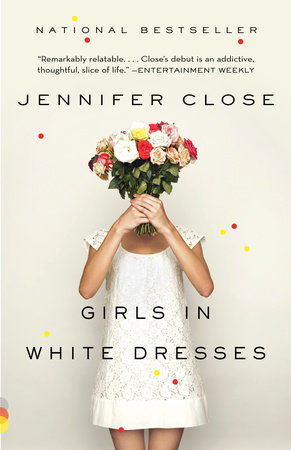Reading Group Center
- Home •
-
Books by Category •
- Imprints •
- Authors •
- News •
- Videos •
- Media Center •
- Reading Group Center
Newsletter
Sign up for the Reading Group Center Newsletter
Reading Group Resources
Reading Group Guides
Reading Group Tips
News & Features
Connect with Us
One Book, One Community
Community-based reading initiatives are a growing trend across the country, and we're pleased to support these programs with a wide range of resources.
Jennifer Close On Writing Girls In White Dresses
Wry, hilarious, and utterly recognizable, Girls in White Dresses tells the story of three young women grappling with heartbreak and career change, family pressure and new love—all while suffering through an endless round of weddings and bridal showers. In this exclusive essay, Jennifer Close discusses her inspiration for Girls in White Dresses, reveals her favorite part of the writing process, and talks about the response she’s received from readers.
Click to Read an Excerpt | Download Our Reading Group Guide
In the summer of 2008, I was a bridesmaid in three different weddings. This meant three different bachelorette trips, three different showers, and (since none of the weddings were in New York) three different trips to celebrate the actual weddings. By June, I was tired. By July, I was exhausted. And by August, I could barely force myself to unpack my suitcase at the end of a weekend trip.
My days were filled with emails about bouquets and matching shoes. I tracked down blow-up dolls and created games for the bachelorette parties. Almost every Monday, I arrived at the office bleary eyed and sleep deprived. Weddings seemed to be all I thought about…even though I wasn’t the one getting married.
Looking back, it’s no surprise that Girls in White Dresses started to come together during that summer. I had all these funny little bits that I’d started writing, but I didn’t know how (or if) they would ever fit together.
One of the first scenes that I wrote featured a group of girls at a friend’s wedding shower. At that point, it was all dialogue—I didn’t even know who was talking! I just wrote down their conversation and it made me laugh, so I saved it.
Isabella was the first character that came to me. I wrote about her visit to her hometown during her first couple of years living in New York. Soon after that, I wrote about Lauren working as a waitress with a bartender that had previously dumped her. Then I wrote the story of Mary and her mother in law, Button.
As I continued to write, the same characters kept popping up. And soon, I realized that these characters were all friends with each other and I began to see it all come together like a puzzle. That was probably the most exciting part of the writing process—it was like everything started to click and I began to understand the friendships of the girls and how they all fit in to one another’s lives and stories.
In almost every chapter of the book there is some mention of a wedding. Still, it always surprises me when people describe Girls in White Dresses as a book about weddings. I think of it as a book about being in your twenties. And in your twenties (whether you’re getting married or not) weddings are a part of your life; weddings are just something that happen to you.
For me, the most important relationships in the book are the ones between the girls. Some of them are getting promoted and succeeding in careers they love and some are waitressing. Some of them are getting married and having babies and some are going on blind dates. And while their lives are going in these different directions, their friendships have to adjust. Some of them are closer by the end and others have sort of faded away.
When I first met my editor, she tapped my manuscript and said, “I know these girls.” I knew then that she was the perfect fit to edit Girls in White Dresses. When the book was released, all I could hope was that when people read it, they would recognize their own friendships in the girls, and see some of the same struggles that they faced or were facing. To this day, nothing makes me happier than when a reader says, “I felt like I was reading a book about my friends.” Every time I hear that, it makes me feel like my book was a success.


